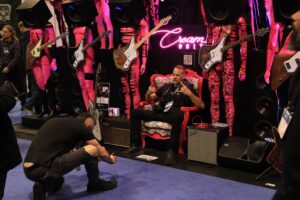By Carlos Martin Schwab
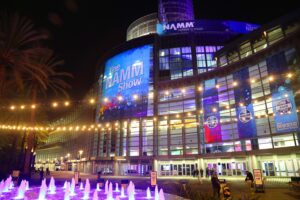 I’m already tired of seeing the #NAMMSHOW sculpture photo, so I chose a different photo here (I hope you like it too). Despite the absences, NAMM 2024 was awesome. The numbers show 62,000 attendees, 33% more than in 2023, but still far from the record 115000 attendees in 2020. The number of exhibitors also increased: 33% more than in 2023.
I’m already tired of seeing the #NAMMSHOW sculpture photo, so I chose a different photo here (I hope you like it too). Despite the absences, NAMM 2024 was awesome. The numbers show 62,000 attendees, 33% more than in 2023, but still far from the record 115000 attendees in 2020. The number of exhibitors also increased: 33% more than in 2023.
Concerts and education were significant: over 200 artists performed over 5 days on 2 outdoor stages, one arena, and several at nearby hotels.
All performances were free. Notable names included Lindsay Stirling, Jon McLaughlin, and Chris Rocha. About education, more than 200 sessions led by more than 650 speakers were presented for every professional community – retail, brands, pro audio, music technology, entertainment technology, music educators, students, nonprofits, artists, and more.
The most important absentee companies: Gibson Group, Fender Group, PRS, Kiesel, and all the most important string brands except Ernie Ball. There were no major absentees in pro audio.
NAMM will return to only three days in 2025, on Jan 23-25. Based on this and the importance of the absent companies, many think that NAMM will shrink over the years, something I don’t want to see happen because I have already seen Musikmesse die.
For traditional media, something sad to notice is that John Mlynczak, the new CEO of NAMM, is giving too much importance to influencers (YouTubers mostly). Considering that NAMM always neglected the traditional press and that many influencers are just clowns, NAMM is again belittling it when it needs it the most.
Crazy pre-NAMM Wednesday: I was planning to attend the NAMM Global Media Day when I received an invitation from Gibson PR to attend the Gibson Pre-NAMM Los Angeles Showroom Event, so I changed my plan. I spent 6 hours out of Anaheim: 4 in a car (the traffic to LA is hell) and 2 attending an Audiomovers Omnibus demo (an audio routing software) at the Universal Studios in Santa Monica and the Gibson event. I expected to see the Epiphone Adam Jones Les Paul Custom Art Collection there, but only the NAMM launches were in the exhibition.

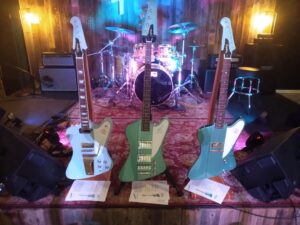
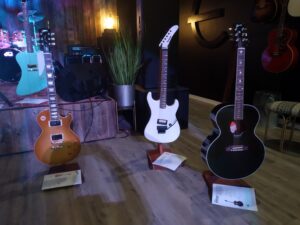
I returned to Anaheim just in time to meet up with a friend and attend a Taylor event together. As we entered, we saw the 50th-anniversary collection, 15 guitars with a terrific setup and sound. We stopped playing them only to talk with Bob Taylor and have dinner. That event made my day.

What I came across…
Musicians: Geezer Butler (Black Sabbath), Devin Townsend, Doug Aldrich (Whitesnake, Dio), Matteo Mancuso, Tosin Abasi and Javier Reyes (Animals as Leaders), Ola Englund, and Aaron Marshall (Intervals).
Half rounds and flatwound strings for guitar are back: Ernie Ball launched the Flatwound Stainless Steel Series for guitar and bass, and Thomastik-Infeld released the Infeld 12, a flatwound string set specially designed for Rickenbacker 12 string guitars. Galli Strings had several half rounds and flatwound string sets available too. Flatwound strings last longer than roundwound ones because they retain less sweat and dirt, have a flat wrap, and are smoother.
New technologies applied to strings…
Santa Cruz Parabolic Tension Acoustic Strings: While a gauge is simply the measurement of the string’s diameter, the tension of a string determines its relative volume to the other strings (EQ). String tension is determined by its core-to-wrap ratio, which can vary greatly among manufacturers. This can create multi-pound differences between brands and an illogical EQ within any given set.
Santa Cruz Strings are engineered to put the exact tension on each string to create the appropriate download pressure. These calculated tensions determine your instrument’s optimal relative volume between strings or EQ. Its manufacturing requires precise core-to-wrap ratios and precision fit and finish for unprecedented tolerances of one-half of one-thousandths of an inch. This accurately determines the tension/volume of each string to the exact EQ your guitar was designed for. State-of-the-art metallurgy and micro-coating ensure long life by preventing corrosive moisture from contacting these nickel’s and lead-free strings’ cores. You can check them at this link. A review article is under development.
Cleartone EQ Hybrid Metal Acoustic Strings: These strings are the world’s first materially tuned Acoustic strings. Like a stereo EQ, all four of the wound strings are manufactured using a different alloy to get a perfect EQ balance and to highlight the string’s natural voice: pure Copper for the low E string due to its increased bass response, the A and D strings are made using the purest Phosphor Bronze for that medium-low midrange fullness, and the G string is 80/20 for some mid-range brightness. Additionally, all six strings come with the twice-patented Cleartone treatment for extra longevity, increased volume, and longer sustain. Check this link for more info.
More strings brands using coating technology: This technology started with Elixir strings years ago, followed by D’Addario, DR, Ernie Ball, and GHS. At NAMM, using micro-coating technology, I found Stringjoy, Pitbull Strings (Turkey), Aurora, Galli Strings, Santa Cruz, and Cleartone. It is estimated that a coated string has a useful life of 3 to 5 times longer than an uncoated one, so it is a fact that this technology is here to stay and improve, leaving uncoated strings for purists.
How did no one think of this before? La Bella Tony Iommi’s Custom Guitar Strings. Iommi has 2 main guitars for D# and C# tunings, and he has a custom set on each:
D# Standard: .008 – .008 – .011 – .018w – .024 – .032
C# Standard: .009 – .010 – .012 – .020w – .032 – .042
These string sets are light by any standards, but especially so when considering that he is tuning his guitars below standard. Iommi has used La Bella strings since 1990 and this company launched these custom sets as Tony Iommi Signature Strings. You can check them at this link.
New designs in capos (despite this, the eternal Kyser capo everybody has is still handy, clamping at the headstock as no other):
G7th: they have Adaptive Radius Technology® (ART®), a patented mechanism created by G7th that sits underneath the string pad on both the Performance 3 and Heritage capos. When the capo is attached to the guitar, the ART® automatically responds to the radius of your guitar neck and the gauge of your strings to perfectly distribute pressure over the strings, giving you maximum tuning stability with the minimum tension required.
The biggest complaint from guitarists about capos is the lack of tuning stability – put on the capo and it pulls your strings sharp. While the severity of the problem depends on many factors, including the pressure put down by the capo, string gauges, action height, and fingerboard radius, the problem is not completely solved by being able to adjust the pressure on your capo.
The fundamental problem remains – the pressure is not evenly distributed, which causes some strings to be pulled out of tune, frustrating beginners to professional guitarists. The ART® string pad distributes pressure over the strings perfectly by responding to the fingerboard radius of the guitar on which it is placed, avoiding this usual problem. You can check it at this link.
The G7th Newport 12 String capo is specifically designed for 12-string acoustic and electric guitars and combines a flip-lever action, a low-profile shape that doesn’t get in the way of your fretting hand and its patented Compensated String Pad®, which allows all 12 strings to fret at the same time and under the same tension compensating for the different gauges of strings using carefully designed ridges in the silicone string pad, dramatically reducing tuning problems while fretting all 12 strings securely and accurately. Check this link for more info.
Glider capo: Imagine a capo that allows you to keep playing through seamless key changes and you could roll with the pick hand or the thumb while pressing the strings with a rubber cylinder in the front and a double rubber cone in the back. Designed by Greg Bennett (I have a Samick Greg Bennett acoustic guitar and love it), it opens new playing possibilities in 6-string acoustic and electric guitars. You can check it at this link.
New designs in slides: Thimble Slide. It is a mini-slide designed to be worn on the tip of your 3rd finger, with the front edge about halfway to 3/4 down the fingernail toward the base. Worn there, all your fingers are free for fretting. You can still bend your knuckle, and it is angled front allows enough fingertip through so you can still press the strings. Check this link for more info.
Guitar maintenance: the Fret Butter, from dmi guitar labs, is a wet cleaner cloth that, in one simple operation, removes fingerboard grime and oxidation from frets, hydrates the fingerboard leaving it with a satin touch, and prevents corrosion from sweat, acids, and other destructive elements. It’s safe for nitro, poly, UV-catalyzed, and waterborne finishes. You can check it at this link.
There were many new guitar processors: IK Multimedia Tonex pedal integrated to Tonex plugin (both with high-quality hardware capture technology), Blu Guitar Amp X, Mooer GE1000, Hotone Ampero II Stage (the most powerful Hotone processor), and Nux NME-5 Trident Guitar Processor.
Ah, guitars…
There were beautiful guitars everywhere (for example, the ESP Signature Series, ESP Custom Series, and the Ibanez Signature Series), but the most beautiful ones were in these 2 places:
1) Boutique Guitar Showcase:
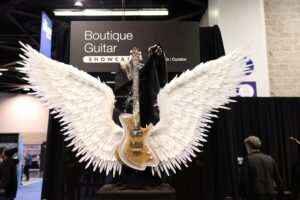
![]()
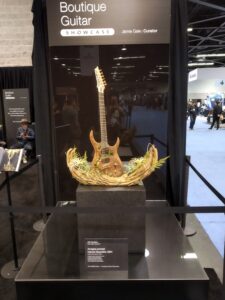
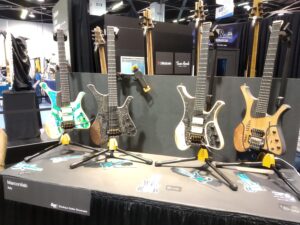
2) Cream Guitars: Imagine a bowl with colorful objects or glitter inside immersed in solidified transparent resin. That is the aesthetic description (designed by the CEO; Luis Ortiz) of the front of the body of the 2 guitar models of this Mexican firm: the Voltage (HH) and the Revolver (HSS + piezo).
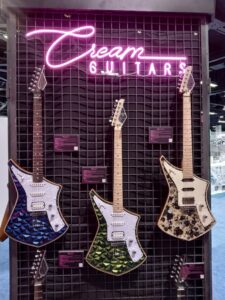
As functional features, they have a headstock insert made of aluminum with resin to control guitar response and a brass back insert that connects the neck with the bridge and the string insert so that the guitar does not lose vibrations. For NAMM, the company launched the Voltage and Revolver bass guitars.
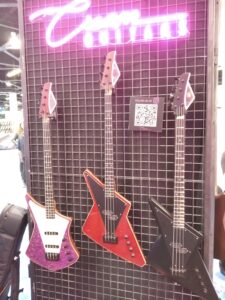
They had even a Voltage guitar that changed colors with electronic ink and an internal electronic circuit sending impulses that made the color change from white to dark grey!
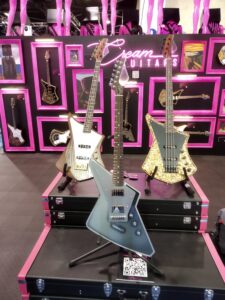
The Cream Guitar booth was the most delirious in all of NAMM 2024 by far. Check this link for more info.
